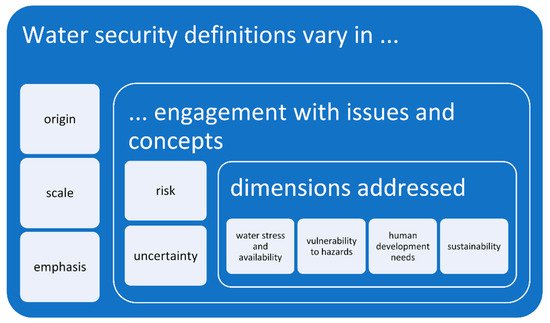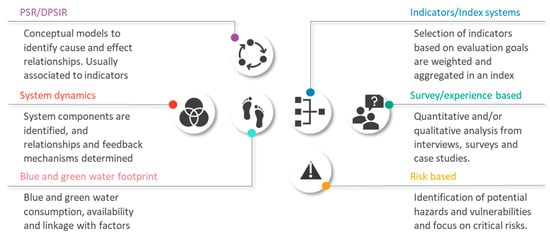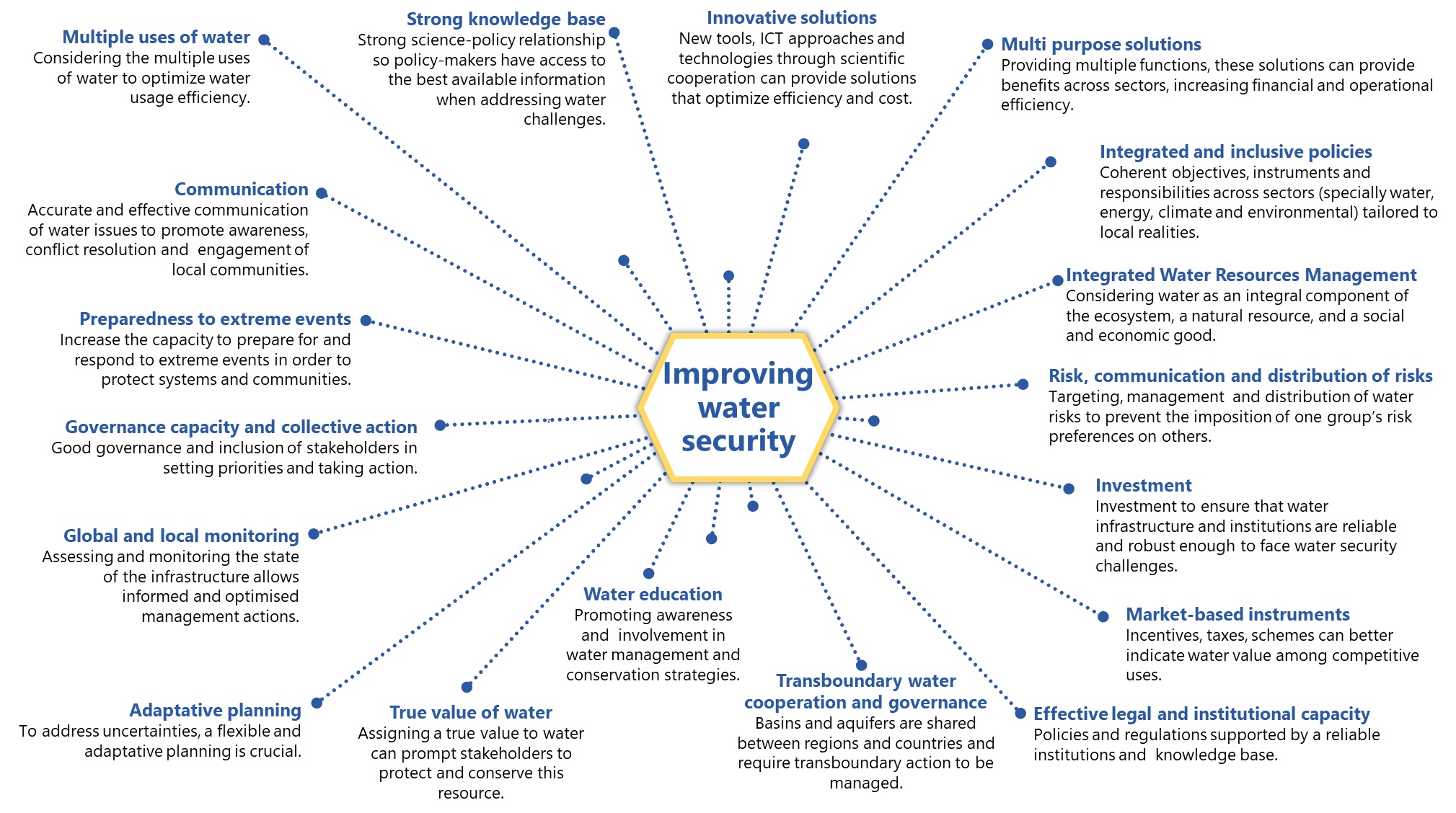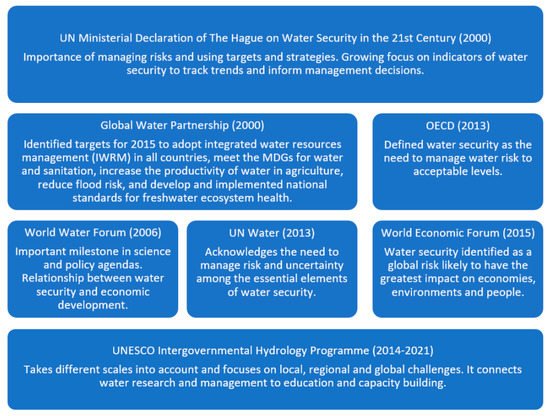Water security is about managing too much, too little and/or too polluted water. Water security is about the increasing importance of sustainable management of water resources, drinking water and human well-being and protection of life and property from water-related disasters. Water security is about the health of ecosystems and economic development. A groundwork of this broad and multi-faceted concept is presented to facilitate understanding, measuring and improving water security.
- water security
- assessment
- sustainable development
- policymaking
- water governance
- innovation
- climate change
1. Water Security Definitions


2. Water Security Assessment
2.1. Overview
2.2. Scales and time dependence
| Scale | Examples and considerations |
| Global | Global water security assessment was carried out by Vorosmarty et al. [26], considering human and biodiversity perspectives: drivers and impacts related to catchment disturbance, pollution, water resource development and biotic factors were quantified at a global scale. Gain et al. [27] also provided a global assessment using the Global Water Security Index, using indicators based on SDG 6. |
| National/ Country |
Usually encompassing all four dimensions from the UN definition [28], frameworks such as the National Water Security Index [29][30] from the Asian Development Bank, the Water Security Scorecard [31] from the Australian Water Association and others developed by scholars such as Dou et al. [32], Marttunen et al. [33], Su et al. [34], Lautze et al. [35] look at water security at a national scale. The National Blueprint Framework [36], although not designed for water security specifically, provides indicators to measure progress on SDG 6. |
| Basin/ Watershed |
With a focus on water quantity aspects such as availability, utilisation and scarcity resources, frameworks at this scale also bring attention to climate change aspects and governance since watershed or basins do not follow administrative boundaries of cities or states, with concerns over the surface and groundwater quantity and quality at this scale often requiring transboundary cooperation. Works developed by scholars such as Babel et al. [37], Yin et al. [38], Xiao et al. [39], Norman et al. [40], Jia et al. [41] provided frameworks for basins of watersheds. Notably, the use of hydrological models is often used, providing valuable predictions. |
| Regional | An intermediate between the city and national context, studies at a regional scale usually follow administrative boundaries of regions or provinces, sometimes comprising several basins and smaller regions. Encompassing not only urban areas but also areas of different land uses, considerations around agricultural activities, ecological and environmental aspects are present. Scholars such as Liu et al. [42], Li et al. [43], Zhang et al. [44] provided regional evaluations. |
| City/ Urban |
The urban level frameworks tend to incorporate many aspects regarding availability, access and reliability of water services, governance, water hazards, etc. One of the key dimensions of the National Water Security Index by the ADB [29], notable frameworks such as the City Blueprint Approach (KWR) [15], Sustainable City Water Index (Arcadis) [14] and the City Water Resilience Index (ARUP) [20] are city-specific. As are works from scholars such as Van Ginkel et al. [13], Jensen et al. [12], Ghosh et al. [45] and Romero-Lankao et al. [46]. |
| Community | At this scale, frameworks show concern with management strategies, governance and other social aspects. The Canadian Water Sustainability Index (CWSI) [47] was developed to assess the well-being of communities with respect to water. The WaterAid [48] framework highlights the importance of a participatory process involving the community. Authors such as Wutich et al. [49], Shrestha et al. [50], Norman et al. [40] and Dickson et al. [51] considered communities as the scale to assess water issues. |
| Household/ Individual |
Focus on essential needs (access to water and sanitation) and aspects related to health and hygiene, social and gender inequality, emotional stress and food security are present at this scale. One key dimension of the National Water Security Index by the ADB [29], and sometimes described in terms of water insecurity, this level has also been assessed by scholars such as Jepson [52], Hadley and Wutich [53], Wutich [54], Brewis et al. [55], Webb [56] and Tsai et al. [57], among others. The HWISE-RCN by Young et al. [23] is notably investigating experiences, causes and outcomes of water insecurity at the household level. |
2.3. Approaches and Methodologies for Water Security Assessment

2.4. Water Security Indicators

Figure 6. Water security dimensions based on the UN definition [8].
| Dimension | Categories | Indicator / aspects |
| Drinking water and human well-being |
Water quantity | Water availability, adequate quantity for basic needs, demand and consumption; diversity of sources; precipitation and water balance; water storage; exploitation of resources; water stress and usage efficiency. |
| Quality | Quality of water for human consumption (meeting standards); aesthetic, perception and quality acceptability; water treatment practices. | |
| Access to water services | Access to improved drinking water source; improved sanitation; piped water or water supply connection; accessibility of water points; affordability of services; wastewater collection/sewage connection. | |
| Infrastructure reliability | Asset management and maintenance; infrastructure condition/age and capacity; reliability (complaints/blockages/interruptions); service level; service continuity (hours of service); water leakage, non-revenue water. | |
| Reuse/ recycling |
Water/wastewater reuse; energy or nutrient recovery; rainwater harvesting; solid waste/recycling. | |
| Hygiene and public health | Water-related diseases; incidence of diarrhoea; adequacy of water for housework and hygiene; other health problems. | |
| Wellbeing | Emotional stress, fear, frustration; safety or dispute; deprivation or lost opportunity; recreational opportunities. | |
| Ecosystems | Environment | Surface and groundwater water quality; river health; wastewater generated and adequacy of wastewater treatment; biodiversity; environmental flows; environmental protection actions; pollutants discharge (harmful substances, pollution loading); soil erosion; wildfires; vegetation cover and land use. |
| Sustainability | Energy use/efficiency; renewable energy; sustainable natural resources use; sustainable water use; water sensitive urban design. | |
| Water hazards and Climate change |
Water-related hazards | Floods (frequency, affected area and population, hazard and vulnerability, protection infrastructure); droughts (frequency/vulnerability/area affected); economic loss; landslides; prevention, preparedness and response; water pollution accidents. |
| Climate change | Climate change response; greenhouse gas emissions; salination and seawater intrusion; temperature. | |
| Economic Activities and Development | Economic activities |
Water for agriculture, manufacturing; commerce, energy production; broad economic development; water-related business opportunities; food production and demand; water footprint; water use/GDP or GDP/water use. |
| Governance | Institutional organization and capacity; accountability and corporate governance; data availability, multi-level and multi-stakeholder participation/engagement; communication and transparency; investment/funding and financial management; legal and regulatory aspects; science, knowledge and innovation; strategic planning; transboundary and international collaboration. | |
| Socio-economic aspects | Education and awareness; GDP; income/unemployment rate; informal dwellings; population density; social and cultural aspects; urbanization rate. |
3. From Paper to Action: Measuring Progress, Achieving Goals and Improving Water Security
Indicators play an important role in describing the complexity of a system, dissemination of information and translating important aspects of a complex system into an accessible format that can be understood and monitored by different stakeholders. As a useful tool to identify critical problems, they have the potential to guide governments and decision-makers in developing action plans and making informed political interventions to tackle areas that need attention in order to improve water security.
From water security assessment, case studies, experiences, observations, consultations, etc., authors in the literature have gathered a range of experiences allowing identification of solutions, suggestions or interventions that could help improve water security. From these, certain actions with the potential to help achieve water security goals have been identified (see Figure 7). Sharing these actions is as important as measuring and aiming for water security since the only way to achieve goals and improve water security is going from paper to action and implementing measures.

Figure 7. Summary of actions with potential to improve water security.
4. Concluding remarks
Through different scales and approaches, the evaluation of water-related concepts, in particular water security, is an important step into achieving the SDGs. Although different definitions and frameworks have been proposed in the last decades, research questions around water security, and how to improve it, are still of great relevance. Like the concept itself, water security challenges are multifaceted and facing them depends not only on research and innovation but also on policies, management strategies and governance.
The development of frameworks and the potential to measure water security allows a wider and clearer vision view of water challenges. Investigating water security provides crucial information on this ever-changing, multi-faceted concept, allowing to produce the best possible information on needs and challenges. This fuels research to develop means to better measure and improve water security.
This entry is adapted from the peer-reviewed paper 10.3390/su132413702
References
- World Water Council. Ministerial Declaration of the Hague on Water Security in the 21st Century; World Water Council: Hague, The Netherlands, 2000.
- De Loë, R.; Varghese, J.; Ferreyra, C.; Kreutzwiser, R. Water Allocation and Water Security in Canada: Initiating a Policy Dialogue for the 21st Century; Report prepared for the Walter and Duncan Gordon Foundation; Guelph Water Management Group, University of Guelph: Guelph, ON, Canada, 2007.
- Cook, C.; Bakker, K. Water security: Debating an emerging paradigm. Glob. Environ. Chang. 2012, 22, 94–102.
- Allan, J.V.; Kenway, S.J.; Head, B.W. Urban water security—What does it mean? Urban Water J. 2018, 15, 899–910.
- Gerlak, A.K.; House-Peters, L.; Varady, R.G.; Albrecht, T.; Zuniga-Teran, A.; de Grenade, R.R.; Cook, C.; Scott, C.A. Water security: A review of place-based research. Environ. Sci. Policy 2018, 82, 79–89.
- Global Water Partnership. Towards Water Security: A Framework for Action; GWP Secretariat: Stockholm, Sweden, 2000.
- Grey, D.; Sadoff, C.W. Sink or Swim? Water security for growth and development. Hydrol. Res. 2007, 9, 545–571.
- UN-Water. Water Security and the Global Water Agenda: A UN-Water Analytical Brief; UNU-INWEH, UN University: Hamilton, ON, Canada, 2013; p. 38.
- UNESCO. International Hydrology Programme—Eighth Phase: Water Security: Responses to Local, Regional, and Global Challenges; UNESCO: Paris, France, 2014.
- OECD. Water Security for Better Lives; OECD: Paris, France, 2013; Volume 12.
- Garrick, D.; Hall, J.W. Water Security and Society: Risks, Metrics, and Pathways. Annu. Rev. Environ. Resour. 2014, 39, 611–639.
- Jensen, O.; Wu, H. Urban water security indicators: Development and pilot. Environ. Sci. Policy 2018, 83, 33–45.
- Van Ginkel, K.C.H.; Hoekstra, A.Y.; Buurman, J.; Hogeboom, R.J. Urban Water Security Dashboard: Systems Approach to Characterizing the Water Security of Cities. J. Water Resour. Plan. Manag. 2018, 144, 04018075.
- Arcadis. Sustainable Cities Water Index. Which Cities are Best Placed to Harness Water for Future Success? Arcadis: Amsterdam, The Netherlands, 2016; p. 40.
- Van Leeuwen, C.J.; Frijns, J.; Van Wezel, A.; Van De Ven, F.H.M. City Blueprints: 24 Indicators to Assess the Sustainability of the Urban Water Cycle. Water Resour. Manag. 2012, 26, 2177–2197.
- Gain, A.K.; Giupponi, C.; Wada, Y. Measuring global water security towards sustainable development goals. Environ. Res. Lett. 2016, 11, 124015.
- Asian Development Bank (ADB). Asian Water Development Outlook 2013: Measuring Water Security in Asia and Pacific; Asian Development Bank: Mandaluyong, Philippines, 2013; pp. 1–128.
- OECD. OECD Water Governance Indicator Framework. Implementing the OECD Principles on Water Governance: Indicator Framework and Evolving Practices; OECD: Paris, France, 2018; pp. 49–105.
- Koop, S.H.A.; Koetsier, L.; Doornhof, A.; Reinstra, O.; Van Leeuwen, C.J.; Brouwer, S.; Dieperink, C.; Driessen, P. Assessing the Governance Capacity of Cities to Address Challenges of Water, Waste, and Climate Change. Water Resour. Manag. 2017, 31, 3427–3443.
- ARUP. City Water Resilience Assessment: Methodology; Arup Global Water: London, England, 2019; p. 137.
- Milman, A.; Short, A. Incorporating resilience into sustainability indicators: An example for the urban water sector. Glob. Environ. Chang. 2008, 18, 758–767.
- IWaSP—International Water Stewardship Programme. Water Resources Risk & Action Framework: Tackle your water risks collaboratively. Available online: https://ceowatermandate.org/water-risk-action-framework/ (accessed on 9 September 2021).
- Young, S.L.; O Boateng, G.; Jamaluddine, Z.; Miller, J.D.; A Frongillo, E.; Neilands, T.B.; Collins, S.M.; Wutich, A.; E Jepson, W.; Stoler, J. The Household Water InSecurity Experiences (HWISE) Scale: Development and validation of a household water insecurity measure for low-income and middle-income countries. BMJ Glob. Health 2019, 4, e001750.
- Krause, M. AquaRating: An international standard for assessing water and wastewater services. Water Intell. Online 2015, 14.
- Lombana Cordoba, C.; Saltiel, G.; Sadik, N.; Penalosa, F.P. The Utility of the Future Diagnostic Assessment and Action Planning Methodology; Working Paper; World Bank Group: Washington, DC, USA, 2021.
- C. J. Vörösmarty; P. B. McIntyre; Mark O. Gessner; D. Dudgeon; A. Prusevich; P. Green; S. Glidden; Stuart Bunn; Caroline A. Sullivan; C. Reidy Liermann; et al. Global threats to human water security and river biodiversity. Nature 2010, 467, 555-561, 10.1038/nature09440.
- Animesh K. Gain; Carlo Giupponi; Yoshihide Wada; Measuring global water security towards sustainable development goals. Environmental Research Letters 2016, 11, 124015, 10.1088/1748-9326/11/12/124015.
- What is Water Security? Infographic. . UN-Water. Retrieved 2022-1-21
- Asian Development Bank (ADB). Asian Water Development Outlook 2016: Strengthening Water Security in Asia and the Pacific; Asian Development Bank: Mandaluyong, Philippines, 2016; p. 66.
- Asian Development Bank (ADB). Asian Water Development Outlook 2013: Measuring Water Security in Asia and Pacific; Asian Development Bank: Mandaluyong, Philippines, 2013; pp. 1–128.
- Australian Water Association (AWA). Water Security for all Australians: Discussion Paper; Australian Water Association: St Leonards, NSW, Australia, 2016; p. 19.
- Ming Dou; Yaxin Shi; Guiqiu Li; Optimized urban water security regulation schemes driven by industrial development pattern. Water Policy 2019, 21, 676-691, 10.2166/wp.2019.198.
- Mika Marttunen; Jyri Mustajoki; Suvi Sojamo; Lauri Ahopelto; Marko Keskinen; A Framework for Assessing Water Security and the Water–Energy–Food Nexus—The Case of Finland. Sustainability 2019, 11, 2900, 10.3390/su11102900.
- Yin Su; Weijun Gao; Dongjie Guan; Integrated assessment and scenarios simulation of water security system in Japan. Science of The Total Environment 2019, 671, 1269-1281, 10.1016/j.scitotenv.2019.03.373.
- Jonathan Lautze; Herath Manthrithilake; Water security: Old concepts, new package, what value?. Natural Resources Forum 2012, 36, 76-87, 10.1111/j.1477-8947.2012.01448.x.
- B. Essex; S. H. A. Koop; C. J. Van Leeuwen; Proposal for a National Blueprint Framework to Monitor Progress on Water-Related Sustainable Development Goals in Europe. Environmental Management 2019, 65, 1-18, 10.1007/s00267-019-01231-1.
- Mukand Babel; Victor R. Shinde; A framework for water security assessment at basin scale. APN Science Bulletin 2018, 8, -, 10.30852/sb.2018.342.
- Su Yin; Guan Dongjie; Su Weici; Gao Weijun; Integrated assessment and scenarios simulation of urban water security system in the southwest of China with system dynamics analysis. Water Science and Technology 2017, 76, 2255-2267, 10.2166/wst.2017.333.
- Sheng-Chun Xiao; Jin-Xiu Li; Hong-Lang Xiao; Fa-Min Liu; Comprehensive assessment of water security for inland watersheds in the Hexi Corridor, Northwest China. Environmental Earth Sciences 2007, 55, 369-376, 10.1007/s00254-007-0982-5.
- Emma S. Norman; Gemma Dunn; Karen Bakker; Diana M. Allen; Rafael Cavalcanti De Albuquerque; Water Security Assessment: Integrating Governance and Freshwater Indicators. Water Resources Management 2012, 27, 535-551, 10.1007/s11269-012-0200-4.
- Xiaoli Jia; Chunhui Li; Yanpeng Cai; Xuan Wang; Lian Sun; An improved method for integrated water security assessment in the Yellow River basin, China. Stochastic Environmental Research and Risk Assessment 2015, 29, 2213-2227, 10.1007/s00477-014-1012-2.
- Huan Liu; Yangwen Jia; Cunwen Niu; Yongde Gan; Fei Xu; Evaluation of regional water security in China based on dualistic water cycle theory. Hydrology Research 2017, 20, 510-529, 10.2166/wp.2017.062.
- Zhengzhao Li; Mingjing Dong; Tony Wong; Jianbin Wang; Alagarasan Jagadeesh Kumar; Rajendra Prasad Singh; Objectives and Indexes for Implementation of Sponge Cities—A Case Study of Changzhou City, China. Water 2018, 10, 623, 10.3390/w10050623.
- Yixin Zhang; Zeshui Xu; Huchang Liao; Water security evaluation based on the TODIM method with probabilistic linguistic term sets. Soft Computing 2018, 23, 6215-6230, 10.1007/s00500-018-3276-9.
- Ruchira Ghosh; Arun Kansal; G Venkatesh; Urban Water Security Assessment Using an Integrated Metabolism Approach—Case Study of the National Capital Territory of Delhi in India. Resources 2019, 8, 62, 10.3390/resources8020062.
- Patricia Romero-Lankao; Daniel M Gnatz; Conceptualizing urban water security in an urbanizing world. Current Opinion in Environmental Sustainability 2016, 21, 45-51, 10.1016/j.cosust.2016.11.002.
- National Government. Canadian Water Sustainability Index (CWSI); Policy Research Initiative; National Government: Ottawa, ON, Canada, 2007; p. 27.
- WaterAid. Water Security Framework; WaterAid: London, UK, 2012.
- Amber Wutich; Kathleen Ragsdale; Water insecurity and emotional distress: Coping with supply, access, and seasonal variability of water in a Bolivian squatter settlement. Social Science & Medicine 2008, 67, 2116-2125, 10.1016/j.socscimed.2008.09.042.
- Sadhana Shrestha; Yoko Aihara; Arun P. Bhattarai; Niranjan Bista; Naoki Kondo; Kazama Futaba; Kei Nishida; Junko Shindo; Development of an objective water security index and assessment of its association with quality of life in urban areas of developing countries. SSM - Population Health 2018, 6, 276-285, 10.1016/j.ssmph.2018.10.007.
- S. E. Dickson; C. J. Schuster-Wallace; J. J. Newton; Water Security Assessment Indicators: The Rural Context. Water Resources Management 2016, 30, 1567-1604, 10.1007/s11269-016-1254-5.
- Wendy Jepson; Measuring ‘no-win’ waterscapes: Experience-based scales and classification approaches to assess household water security in colonias on the US–Mexico border. Geoforum 2014, 51, 107-120, 10.1016/j.geoforum.2013.10.002.
- Craig Hadley; Amber Wutich; Experience-based Measures of Food and Water Security: Biocultural Approaches to Grounded Measures of Insecurity. Human Organization 2009, 68, 451-460, 10.17730/humo.68.4.932w421317680w5x.
- Amber Wutich; Intrahousehold Disparities in Women and Men's Experiences of Water Insecurity and Emotional Distress in Urban Bolivia. Medical Anthropology Quarterly 2009, 23, 436-454, 10.1111/j.1548-1387.2009.01072.x.
- Alexandra Brewis; Cassandra Workman; Amber Wutich; Wendy Jepson; Sera Young; Ellis Adams; Jam Farooq Ahmed; Mallika Alexander; Mobolanle Balogun; Michael Boivin; et al. Household water insecurity is strongly associated with food insecurity: Evidence from 27 sites in low‐ and middle‐income countries. American Journal of Human Biology 2019, 32, e23309, 10.1002/ajhb.23309.
- Patrick Webb; Maria Iskandarani; Water Insecurity and the Poor: Issues and Research Needs. SSRN Electronic Journal 1998, , , 10.2139/ssrn.3316741.
- Alexander C. Tsai; Bernard Kakuhikire; Rumbidzai Mushavi; Dagmar Vořechovská; Jessica M. Perkins; Amy Q. McDonough; David R. Bangsberg; Population-based study of intra-household gender differences in water insecurity: reliability and validity of a survey instrument for use in rural Uganda. Journal of Water and Health 2015, 14, 280-292, 10.2166/wh.2015.165.
- Assefa, Y.T.; Babel, M.S.; Sušnik, J.; Shinde, V.R. Development of a Generic Domestic Water Security Index, and Its Application in Addis Ababa, Ethiopia. Water 2018, 11, 37.
- Benebere, P.; Asante, F.; Appiah, D.O. Hindrances to adaptation to water insecurity under climate variability in peri-urban Ghana. Cogent Soc. Sci. 2017, 3, 1394786.
- Kangmennaang, J.; Bisung, E.; Elliott, S.J. ‘We Are Drinking Diseases’: Perception of Water Insecurity and Emotional Distress in Urban Slums in Accra, Ghana. Int. J. Environ. Res. Public Health 2020, 17, 890.
- Aihara, Y.; Shrestha, S.; Kazama, F.; Nishida, K. Validation of household water insecurity scale in urban Nepal. Hydrol. Res. 2015, 17, 1019–1032.
- Hoekstra, A.Y.; Buurman, J.; van Ginkel, K.C.H. Urban water security: A review. Environ. Res. Lett. 2018, 13, 053002.
- UN-Water. What is Water Security? Infographic. Available online: https://www.unwater.org/publications/water-security-infographic/ (accessed on 2 September 2021).


